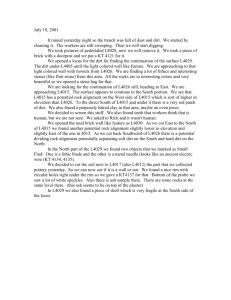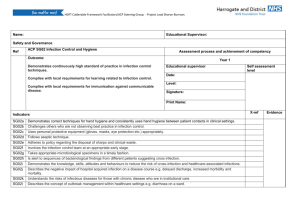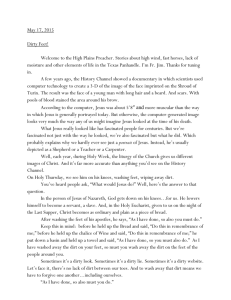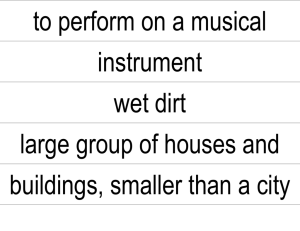Dirt and disgust as key drivers in nurses` infection control behaviours
advertisement
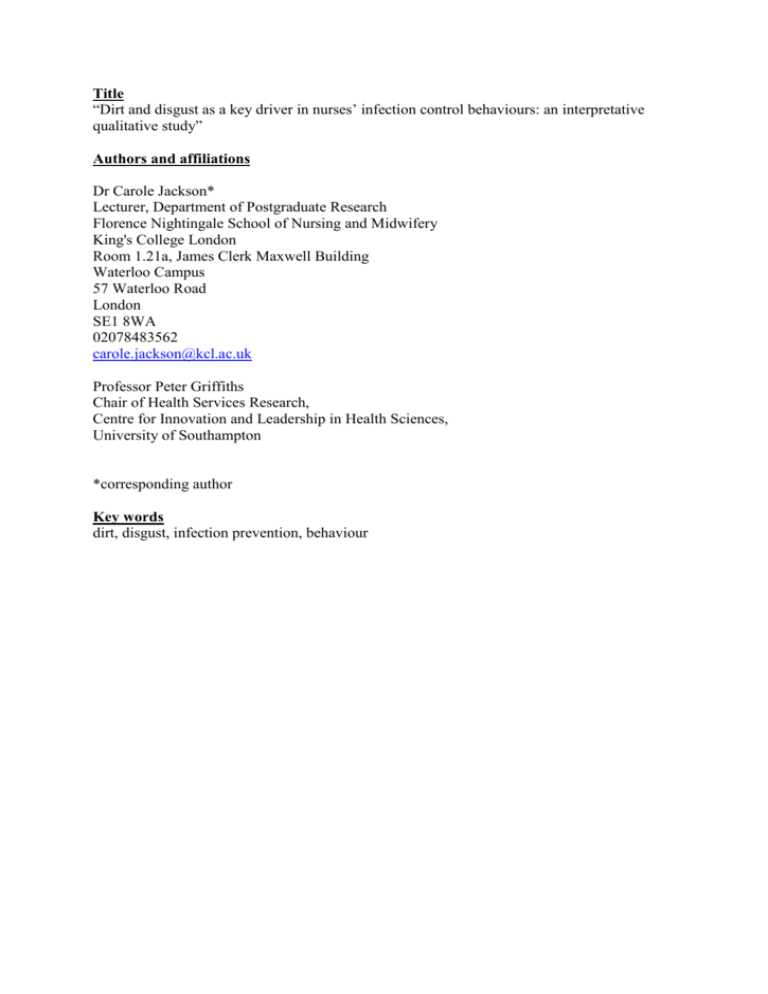
Title “Dirt and disgust as a key driver in nurses’ infection control behaviours: an interpretative qualitative study” Authors and affiliations Dr Carole Jackson* Lecturer, Department of Postgraduate Research Florence Nightingale School of Nursing and Midwifery King's College London Room 1.21a, James Clerk Maxwell Building Waterloo Campus 57 Waterloo Road London SE1 8WA 02078483562 carole.jackson@kcl.ac.uk Professor Peter Griffiths Chair of Health Services Research, Centre for Innovation and Leadership in Health Sciences, University of Southampton *corresponding author Key words dirt, disgust, infection prevention, behaviour Background: Infection prevention and control remains a significant global challenge for healthcare systems. Yet despite considerable work to provide clear policies and scientifically proven techniques to reduce infection transmission, beliefs and practices of healthcare workers do not always concur with any scientific rationale. Hygiene behaviour can be influenced by many factors, and does not always lead to the correct procedures and appropriate behaviour being carried out. Aim: To provide explanations for nurses’ infection prevention behaviours. Methods: An interpretative qualitative approach was taken using semi-structured interviews and vignettes developed from participants’ reports of observed practice. Twenty interviews with registered nurses working in an acute hospital setting were conducted. Analysis was conducted using a framework method. Findings: This paper presents one of three themes “Protection from dirt”. Within the findings clear distinction was made between infection and dirt. Fear of contact with dirt; particularly dirt belonging to those who were unknown, was a key driver in behaviour carried out to reduce threat. Familiarity with the patient resulted in a reduction of the protective behaviours required. These behaviours which initially appeared as part of an infection prevention strategy were primarily a form of self protection from patients, who at first encounter were considered as dirty. Conclusion: Behaviours do not always fit with a rational response to infection; and are reported as a response to dirt. Any programme that simply attempts to address scientific knowledge and behaviour deficits is unlikely to have the desired goals if it does not take into account existing social constructions of dirt and the response it evokes. Key words, - dirt, disgust, infection prevention, behaviour Introduction The control and prevention of infection within the hospital setting presents a significant challenge for healthcare systems worldwide and constitutes a considerable drain on resources. Preventable deaths from healthcare acquired infections continue to occur despite wide reaching initiatives and the increase in scientific knowledge and understanding of infection aetiology. In the United Kingdom, there has been recognition since the 19th century that hygiene and cleanliness play a pivotal role in standards of care, infections transmission continues to present a major problem for health services1. In response, considerable work has been undertaken to provide clear policies and scientifically proven techniques to reduce infection transmission. Yet despite this, beliefs and practices do not always concur with any scientific rationale2 and may be driven by other factors, for example culture as considered by Douglas3 or by automated hygiene behaviour initiated through feelings of disgust, as argued by Curtis4. While Douglas3 asserts that culture is the driving force that creates the concepts of dirt and taboo Curtis4 challenges this notion, drawing on comparison from the natural world and seeing disgust of dirt as an instinctual response influenced by evolution; hygiene being seen as automated rather than higher level thinking. Curtis5 argues that humans posses an automated hygiene behaviour through feelings of disgust which exists to produce avoidance of elicitors and thus avoidance of contamination, rather than needing higher level thinking to avoid dirt or disease. This thinking and level of response will of course have implications for healthcare workers who at times are required to act against the automated response of avoiding contamination as their role can involve contact with potential contaminants. The behaviours may be influenced by the conflict between automated thinking and what is learnt through education and training, or seen in clinical practice. Additionally if there is a gut feeling to avoid sick members of society5 healthcare workers may experience a conflict in their role, through their close contact with the sick, which compromises the need to protect self. This conflict, combined with gut feeling may play a significant part in how healthcare workers behave. If this response leads to the correct procedures and appropriate behaviour being carried out then it would not need addressing further. However evidence suggests that this does not always happen or that behaviour is not always ‘correct’ and may in some instances be identified as harmful6. Nurses provide a significant percentage of the healthcare workforce and Curtis’5 view could provide a novel explanation for their behaviours in an attempt to understand how practice is enacted, and in considering the scientific view of infection versus natural instinct. This paper presents one of three themes from a larger study which sought to identify what influenced nurse inflection prevention behaviours. Through eliciting their explanations of protective behaviours; the study identified the concept of dirt as opposed to infection and the disgust that this dirt provoked, thus providing insight into behaviour which has not previously been fully explained. Methods An interpretative qualitative approach using in-depth interviews was used to explore nurses’ infection prevention behaviours, their perceptions of risk and contagion, and the explanations they provided for their own and others’ behaviours. The study was designed in two stages, so that data from discussion around observed infection prevention behaviours, particularly those deemed inappropriate, collected in the first stage could be analysed and used to present a representation of practice, in the form of a vignette to the participants in stage two. Registered nurses working in UK acute settings were interviewed over a 14 month period in two distinct stages. Participants were approached while attending a professional development course at a local university. Nurses were excluded if they were not working in an acute setting or were not in a position to observe and comment on practice; additionally it was a requirement of the course they were studying that they had been qualified for a minimum of one year and had some experience of working as a qualified nurse. Thirty registered nurses expressed an interest in the study and twenty were interviewed. The sample was both convenient and purposeful. Stage one consisted of eight semi-structured interviews using a topic guide developed from the literature focusing on their perception of risk in the hospital setting, their concerns regarding the potential to contaminate family and friends and whether they believed that policies influenced their own practice. This was combined with a discussion around observed infection control behaviours, particularly those deemed inappropriate by the participants. Data from this discussion part of the interview were analysed and used to develop a representation of practice in the form of a vignette. For example a number of participants described seeing healthcare workers wearing gloves and aprons to carrying out routine observations on patients who did not have a recognised infection and posed no infection risk. This type of behaviour was then incorporated into the vignette as “a nurse is recording the blood pressures of all the patients. She is wearing the same gloves and an apron which she keeps on for all 8 patients” Stage two consisted of the same semi structured interview and a discussion around the vignette with the remaining 12 participants. Participants were asked whether they recognised the behaviours in the vignettes and for any explanations of behaviour they considered inappropriate Interviews lasted between 30 and 45 minutes, were audio taped, transcribed verbatim and analysed using the framework method, which comprises a set of predetermined analytical phases7. Any identifying information was removed and participants were allocated pseudonyms to maintain confidentially. Stage one interviews were subject to initial preliminary analysis to facilitate the development of the vignettes. Full analysis of all interviews was also conducted. This analysis commenced with familiarisation of the data by a process of immersion. Preliminary emerging issues and themes were recorded allowing data to be organized. During stage one of the research this phase of the analysis also allowed recurring observed behaviour to be identified and incorporated into the vignettes. Only behaviours identified by two or more participants were considered for the vignette development. A thematic framework was then identified by drawing on the topic guide and the emerging themes and by recording any recurrence or prevailing patterning. The next phase, indexing of the data, was completed by applying the framework to all the interview transcripts. In the final phase the data were considered again as a whole, the main focus being to provide explanations, although other elements of the process enhanced the findings and added insight. In the final interviews no new themes emerged and the data generated confirmed what previous participants had said, thus no further interviews were conducted beyond 20. All participants were sent verbatim transcripts of their own interviews at the end of each interview stage and asked to comment on them as a process of member checking8. Participants in the final stage were also sent emerging themes. The responses did not identify any discrepancies with the content of the interview or the emerging themes, comments related primarily to respondents’ own use of language and emerging themes were not influenced by any feedback received. Finally an independent nursing academic reviewed the data and identified comparable themes thus increasing credibility. Participants In total thirteen female and seven male registered nurses who had been qualified for between 1 and 20 years were interviewed. Ages ranged from 24 to 53 with 40% in the 24-20 age group. Their education level was undergraduate diploma (60%), undergraduate degree (30%) and post graduate degree (10%). Findings Three main themes were identified from the data analysis. Previously we have discussed how the data identified a show that these nurses were performing 9 here we present our findings in terms of how they perceived and managed dirt. The theme presented here “protection from dirt” consists of 2 subthemes and revolves around dirt and contact with dirt. This was a constant thread throughout the data and a principle driver in behaviour. Protection from dirt A notable finding was that the term ‘dirty’ was used to describe patients but this did not always equate with infection and it appeared that perceptions of ‘dirt’ influenced behaviours quite powerfully. Participants discussed the use of protection even when they knew it was not appropriate; the avoidance of contact with dirt and body fluids; and the disgust that this contact provoked. Conversely, participants also discussed situations where precautions were not taken even when the scientific evidence indicated otherwise. These situations were attributed largely to the patient being perceived as less dirty; here evoked disgust was lower, even though objective infection risk was not significantly affected. Many of the behaviours discussed, both observed and enacted, were better understood as evoked responses to disgust or as socially mediated responses to dirt, rather than as “scientific” infection prevention. The 2 subthemes consider “what nurses see as dirt” and “how dirt is managed”. What do nurses see as dirt? All participants identified that contact with patients could involve contact with infection and dirt. A distinction was made between that which was infected and that which was dirty. Infection had tightly defined boundaries and participants all identified that infection could be clearly defined and named microbiologically. Dirt on the other hand could compose of germs, bacteria and waste products but not necessarily any identified infection. Body debris, such as old skin cells or any water that had been used for washing and was contaminated by body debris, was considered dirty or unclean. At times terminology became confused; however careful analysis revealed that germs and bacteria were considered as dirty and unclean, but not infectious until identified as such by microbiological testing. Participants all identified that known infection could be treated as a separate entity from something that was dirty. Identified infection simplified behaviour because the rules were clear and protection was needed against harmful micro-organisms. Participants were discussing dirt not infection and making a clear distinction: “but on the skin itself there’s a lot of dirt, there’s a lot of germs, or bacteria or whatever it is, living on the skin anyhow ” Roger. Participants were also concerned about what patients may have on their hands and feared that patients may have touched certain forms of dirt, particularly faeces and that this could be transferred. While this was not identified as an infection risk participants indicated that any unexpected contact with dirt should be avoided, meaning that precautions should be taken when suspicion arose. Faeces, the biggest threat to all participants, were the most predominantly discussed waste product or bodily fluid. In particular participants express revulsion at adult faeces and discussed how they would take precautions to avoid it and protect their hands, as hands contributed significantly to the transmission of faeces and consequently pathogens. However participants reported not avoiding children’s faeces to the same extent although the pathogens are potentially the same. There was more disgust attached to an incontinent adult’s faeces, perhaps because children are not expected to be in control of faeces until a certain age, whereas incontinence is viewed negatively in adulthood. When confronted with a baby’s or child’s faeces in a nappy order is to some extent maintained; this faeces is expected, whereas an encounter with adult diapers or continence aids is not accepted in the same way. The focus of participants’ reported behaviour during patient contact was to protect the nurse not the patient; behaviour was not a service conducted for the patient. Dirt and in particular faeces caused disgust, revulsion and a threat to self. Participants described common practices that were carried out in the care setting where contact with patients occurred, included the recording of physical data, assisting with toileting and general hygiene practices. Washing a patient was commonly identified as a procedure where protection from dirt was needed. Although some participants felt that gloves were only necessary for washing patients when there was a potential for contact with high risk body areas, identified as fingers, toes and genitalia, the constant theme arising was the preconceived idea of how dirty the task was likely to be. For example Tanya talked about the nature of washing a patient and the concept of whether this was dirty or not: “I don’t know if it’s [washing a patient] a threat, but I suppose if you have a preconceived idea that this is a process that’s dirty, then you want to protect yourself whether you can get infected or not. If you’re just thinking that giving someone a bath is a dirty process, then you want to protect yourself by wearing the gloves” Tanya. She went on to rationalize that if washing was removing dirt and cleaning then that dirt would transfer to hands if gloves were not worn. This behaviour was not concerned with infection but centred on dirt and uncleanliness and was primarily for self protection. How is dirt managed? While behaviour was influenced by how ‘dirty’ a task was perceived to be it was also influenced by a value judgement about the patient’s level of cleanliness. Participants reported making informal assessments of patients’ level of cleanliness when they first encountered them, treating every encounter as a potential for contact with dirt. Despite the overriding view that all patients were dirty, some, after an informal assessment could be attributed with hygienic practices. This meant that they could be treated less cautiously and self protection practices, for example wearing gloves when assisting with hygiene, could be relaxed. This assessment of risk was based primarily on the amount of time they had known each patient and their hygiene behaviour, although the appearance of being clean was also considered. While dirt was identified as something that needed to be avoided there was a clear distinction made between dirt that was known and dirt that was unknown. Furthermore dirt and bodily waste of the participant’s relatives and close friends were viewed very differently from that of unknown people. For example gloves and protective clothing did not need to be worn when washing relatives or close friends. This change in reported behaviour was also linked to the notion that washing unknown patients posed a greater threat of contact with dirt. Nancy discussed how she had showered her sister as a hospital inpatient without considering contact with dirt, however when asked about showering a patient she stated that she would have worn gloves for protection because she did not know them: “If it would have been a non relative, I would put gloves on, yes. Well I would have done, yes” Nancy. Relatives dirt could be familiar and was considered more acceptable and less potent due to this impression of knowing. Family were, in effect, less dirty irrespective of any objective status. This familiarity plays a significant role in the behaviour of the participants, both in relation to relatives and patients. Unknown patients seemed to pose the biggest threat, as participants were unfamiliar with patients’ hygiene practices, their dirt and germs. Precautions needed to be taken to avoid any unknown dirt until an informal assessment of the patient’s habits and level of cleanliness could be completed. It was acknowledged that behaviour towards patients changed as they became known, for example, “… I think people just get complacent and they get used to nursing somebody, you know, initially they may not need to be gowned up, but people take those precautions” Carol. “......., so after a month or maybe after a few days, I know the person’s hygiene standards. So what it is necessary to do for me I know, he’s now a known client to me, he’s no longer a stranger ...” Roger. Regardless of whether the patient was known or unknown, dirt from adults and children was viewed differently by all but 2 of the participants. Only these two participants had any children’s nursing experience and they recognised that children could be unhygienic and pose a threat; for them children could be just as dirty as adults and as unknown patients, the threat they posed was perceived to be the same. The remaining participants talked about children within their family or children they knew, with some commenting that dirt or faeces belonging to any child, whether known or not, would not be a threat. Nancy discussed changing a soiled baby’s nappy and when asked about wearing gloves to do this she responded that she had never done this, it was not the ‘norm’ and ‘nobody ever has done’. However she went on to explain that for adult faeces this would be different and gloves would be worn: “Yes, I would!...Because my father .....I had to look after him in hospital for two weeks. And he’s doubly incontinent, and I had to wear – well I chose to wear gloves because there was a lot more spillage for starters and yes, but with a baby you don’t, do you? Nobody ever has done”Nancy. Other participants commented on the fact that adult faeces were disturbing and different from that of a baby: “Yes, it’s the same with babies’ nappies are different to, you know, cleaning up somebody, a healthy adult” Jean. “I don’t know if offensive is the right word, but it’s more disturbing” Vicky. A grading of risk from faeces emerged from the data with all adult faeces posing a risk and needing protection, this increased if they were from an unknown person. Children’s faeces were less of a risk with faeces from a known child being the most acceptable and presenting the least risk. Discussion and recommendations In this study distinctions are made between dirt and infection, and fear of contact with dirt, particularly unknown dirt, is identified as a key driver in behaviour carried out to reduce threat. In discussing contact with patients participants made a distinction between infection and dirt. Where their assessment of the patient identified a risk of contact with dirt precautions need to be taken. This demonstrates similarities with nurses in Whitby et al’s 6 study of behavioural determinants in handwashing, who reported that they made an assessment of risk of infection based on criteria of diagnosis, the patient’s physical appearance and perceived general cleanliness. Whitby et al’s6 participants also stated that they made an assessment of the degree of cleanliness or dirtiness of the patient which has some parallels with this study. However in the current study assessment was driven more by the need to identify risk of unknown dirt, not necessarily infection risk. Familiarity with the patient and their hygiene also influenced these practices resulting in a reduction of the protective behaviours required. These practices, which initially appeared as part of an infection prevention strategy, were primarily a form of self protection from patients who at first encounter were considered as dirty. The need for protection is reduced as the perceived level of dirt is decreased. Familial relationships, familiarity, being aware of others’ hygiene practices or imposing one’s own hygiene practices and standards on others by virtue of role and position, all reduce the threat from the dirt of others. Knowing in terms of cleanliness was not only linked to social knowing; it involved participants either having direct observation of patients’ hygiene practices and rituals or direct responsibly for their hygiene. A hierarchy of familiarity and reduced risk can be determined from the data as illustrated in figure 1. In determining the hierarchy the data demonstrated that all patients are viewed as dirty at the initial encounter; then through a process of assessment and involvement in hygiene practices the patients become familiar. If participants were actually involved in the daily hygiene care of the patient then a ‘state of cleanliness’ could be achieved. Whereas other studies have discussed the risk of infection from family sources being perceived as considerably less than from non-family members and public sources5, these participants talked more in terms of dirt and familiar germs in relation to the family, and how behaviour could change as familiarity grew especially if the participant had responsibility for their hygiene and could feel confident that they were actually clean. Familiarity with the patient gave a sense of knowing, not only the person but also their hygiene practices, and their germs. Knowing the patient and the source of any dirt and germs reduced the perceived risk. This effect of a known source on response has been reported elsewhere by Case et al10 as has disgust associated with an unfamiliar person being greater than when the source is self or close family: those we share a relationship with are less disgusting than strangers11. According to Stevenson and Repacholic11 ‘source effect’ influences the response to disgust elicitors whether this is visual or olfactory and in nurses the source is dirt from patients, particularly unknown patients. From a scientific perspective the behaviours identified could be seen as irrational because they do not derive logically from known mechanisms. The rationale does however become clearer when protection from the unknown is acknowledged. Nurses behave and respond to situations in ways which they perceive offer protection. In their work they encounter patients who can and do appear dirty and disgust plays a significant part in the response that this evokes and the behaviour that ensues. The ‘source effect’ influences the response to disgust elicitors whether this is visual or olfactory and in nurses the source is dirt from patients, particularly unknown patients10. If the view of Curtis is accepted then this response is not part of cultural upbringing, nor does it stem from education or knowledge of pathogenicity, it is an evolved instinct4 12. A suggestion further supported by Van Dongen as is the assertion that faeces from one’s own child or a child from within the extended family is the most acceptable and least threatening13 14. Much of the reported behaviour in this study is being carried out as part of a protective self defence system that is not fully explained by a rational ‘scientific’ understanding of infection prevention. These behaviours are not necessarily carried out to protect self from infection; nurses do not necessarily fear contagion from infection, rather they are protecting themselves from dirt. If a patient has an identified infection then there are set policies and guidelines which can be adhered to. However, regardless of whether there is infection there is always dirt. Protection practices, which, on the surface, may appear to be infection prevention practices, must be carried out. Furthermore there is a natural response to disgust 15 and some behaviour merely reflects this and it is this response that needs be modified or indeed changed. The behaviours may be influenced by the conflict between automated thinking and what is learnt through education and training, or seen in clinical practice. Education may be ineffective in reducing these behaviours where the natural instinct is towards protection even when evidence demonstrates that it is not required. Programmes to increase compliance with infection prevention procedures have begun to recognise the complex behavioural antecedents of these practices but have typically attempted to instil ‘correct’; scientific rationale without exploring the rationale of existing behaviours16 17. Disgust has been identified as an important part of the behaviour discussed in this study and provides an opportunity to harness this emotion. Porzig-Drummond et al18 considered using the emotion of disgust to promote hand hygiene and their work may be useful in addressing all behaviours that are part of infection prevention practices. A fuller comprehension of these behaviours has the potential to improve the effectiveness of such programmes by addressing the world as it is experienced by practitioners. Strengths and Limitations Although actual practice does not always reflect reported practice19 this study has considered both the participants’ reports of practice and practice that they recognised. The work is strengthened by the use of vignettes which allow informed insiders to discuss behaviours in the third person20. Participants acknowledged that they recognised the behaviours of others in the vignettes thus increasing credibility. In doing this they can in effect discuss others behaviour rather than acknowledging their own and some of the inconsistency between reported and actual behaviour may have been reduced. What this study cannot guarantee is that participants’ reported behaviour was truly representative of what happened in practice, as practice was not actually observed, nor that all nurses would respond in the same way. 1 Department of Health. The Health and Social Care Act 2008. Code of Practice for health and adult social care on the prevention and control of infections and related guidance. DH: London; 2009. Morrow, E., P. Griffiths, Rao, G., Flaxman, D."Somebody else's problem?" Staff perceptions of the sources and control of Methicillin-resistant Staphylococcus aureus." American Journal of Infection Control 2011: 39: 284-291 2 3 Douglas, M. Natural Symbols: explorations in cosmology, 4th Edition, Oxon: New York; Routledge and Keegan Paul; 1996. 4 Curtis, V. A natural history of hygiene. Canadian Journal of infectious diseases and medical microbiology, 2007; 18:11-14. 5 Curtis, V. Dirt, Disgust and disease: a natural history of hygiene. Journal of Epidemiology and Community Health, 2007 61, 660-664 Whitby, M., McLaws, M. L., Ross, R. W. Why healthcare workers don’t wash their hands: a behavioural explanation. Infection Control and Hospital Epidemiology, 2006; 27: 484–492. 6 7 Ritchie, J., Spencer, L. Qualitative data analysis for applied policy research, In Bryman, A., Burgess, R.G., (eds) Analysing Qualitative Data. London: Routledge; 1994. 173-194. 8 Lincoln, Y. S., Guba, E.S. Naturalistic inquiry. Newbury Park: California; Sage. 1985. Jackson, C., Lowton, K., Griffiths, P. Infection prevention as “a show”: A qualitative study of nurses’ infection prevention behaviours. International Journal of Nursing Studies, 2014: 51; 400–408. 9 Case, T.I., Repacholi, B.M., Stevenson, R.I. My baby doesn’t smell as bad as yours. The plasticity of disgust. Evolution and Human Behaviour 2006: 27; 357-365. 10 Stevenson, R.J., Repacholi, B.M. Does the source of an interpersonal odour affect disgust? A disease risk model and its alternatives. European Journal of Social Psychology, 2005: 35; 375-401. 11 12 Curtis, V .Dirt, Disgust and disease: a natural history of hygiene. Journal of Epidemiology and Community Health, 2007:61; 660-664 Van Dongen, E. It isn’t something to yodel about, but it exists! Faeces, nurses, social relations and status with a mental hospital. Ageing and Health, 2001:5; 2005-2015. 13 14 Curtis, V., Biran, A. Dirt, Disgust and Disease; is hygiene in our genes? Perspectives in Biology and Medicine, 2001: 44; 17-31. 15 Oaten M., Stevenson R. J., Case T. I. Disgust as a disease-avoidance mechanism. Psychological Bulletin, 2009: 135; 303–321. 16 Jenner, E.A., Fletcher, B.C., Watson, P., Jones, F.A., Miller, L., Scott, G.M. Discrepancy between self-reported and observed hand hygiene behaviour in healthcare professionals. Journal of Hospital Infection, 2006: 63; 418–22. 17 Korniewicz, D.M., El-Masri, M. Exploring the factors associated with hand hygiene compliance of nurses during routine clinical practice. Applied Nursing Research, 2010:23; 86-90. 18 Porzig-Drummond, R., Stevenson, R., Case, T., Oaten, M. Can the emotion of disgust be harnessed to promote hand hygiene? Experimental and field-based tests. Social Science & Medicine, 2009: 68; 1006-1012 19 Nichols, A., Badger, B. An investigation of the division between espoused and actual practice in infection control and of the knowledge sources that may underpin this division. British Journal of Infection Control, 2008: 9; 11-15. 20 Hughes, R.J Huby, M. (2002) The application of vignettes in social and nursing research. Journal of Advanced Nursing, 2002: 37; 382-386.
